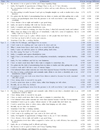Abstract
Purpose
This exploratory study was done to categorize medical personnel's perceptions of burnout and analyzed the characteristics.
Methods
Q methodology was applied using a 45 Q-sample categorized on an 11-point scale which was completed by nurses and doctors working at a university hospital in Seoul, Korea. Collected data were analyzed using the PC-QUANL program.
Figures and Tables
References
1. Chou LP, Li CY, Hu SC. Job stress and burnout in hospital employees: comparisons of different medical professions in a regional hospital in Taiwan. BMJ Open. 2014; 4(2):e004185. Forthcoming. DOI: 10.1136/bmjopen-2013-004185.
2. Moon SJ, Han SS. A predictive model on turnover intention of nurses in Korea. J Korean Acad Nurs. 2011; 41(5):633–641. DOI: 10.4040/jkan.2011.41.5.633.
3. Maslach C, Schaufeli WB, Leiter MP. Job burnout. Annu Rev Psychol. 2001; 52:397–422. DOI: 10.1146/annurev.psych.52.1.397.
4. Goh ER. Effect of burnout experience during internship on specialty preferences [master's thesis]. Seoul: Seoul National University;2010.
5. Kim HJ, Yom YH. Structural equation modeling on burnout in clinical nurses based on CS-CF model. J Korean Acad Nurs. 2014; 44(3):259–269. DOI: 10.4040/jkan.2014.44.3.259.
6. Jung HY, Kim SO, Kim IS. Factors influencing burnout in emergency room nurses. Korean J Occup Health Nurs. 2014; 23(1):1–10. DOI: 10.5807/kjohn.2014.23.1.1.
7. Leiter MP, Frank E, Matheson TJ. Demands, values, and burnout: Relevance for physicians. Can Fam Physician. 2009; 55(12):1224–1225. 1225. e1–1225. e6.
8. Choi YS, Choi YH. Factors influencing burnout of health care provider in emergency medical center- Focused on nurses. Korean J Emerg Med Serv. 2012; 16(2):91–102.
9. Kim WO, Moon SJ, Han SS. Contingent nurses' burnout and influencing factors. J Korean Acad Nurs. 2010; 40(6):882–891. DOI: 10.4040/jkan.2010.40.6.882.
10. Myhren H, Ekeberg O, Stokland O. Job satisfaction and burnout among intensive care unit nurses and physicians. Crit Care Res Pract. 2013; 786176. DOI: 10.1155/2013/786176.
11. Kim MJ, Park YS, Kwon YH. The effects of clinical nurses' resilience and social problem-solving ability on burnout. J Korea Acad Ind Coop Soc. 2015; 16(2):1284–1291. DOI: 10.5762/KAIS.2015.16.2.1284.
12. Al-Dubai SA, Rampal KG. Prevalence and associated factors of burnout among doctors in Yemen. J Occup Health. 2010; 52(1):58–65. DOI: 10.1539/joh.O8030.
13. Jalili M, Sadeghipour Roodsari G, Bassir Nia A. Burnout and associated factors among Iranian emergency medicine practitioners. Iran J Public Health. 2013; 42(9):1034–1042.
14. Poghosyan L, Clarke SP, Finlayson M, Aiken LH. Nurse burnout and quality of care: Cross-national investigation in six countries. Res Nurs Health. 2010; 23(4):288–298. DOI: 10.1002/nur.20383.
15. Siu C, Yuen SK, Cheung A. Burnout among public doctors in Hong Kong: Cross-sectional survey. Hong Kong Med J. 2012; 18(3):186–192.
16. Oh SR. An eco-spiritual program for preventing medical professional's burnout [master's thesis]. Seoul: The Catholic University of Korea;2014.
17. Yoon HS. Effects of the happy arts therapy program to psychological well-being and emotional exhaust in nurse practitioners. Off J Korean Soc Dance Sci. 2013; 29:53–74.
18. Moyle W, Cooke M, O'Dwyer ST, Murfield J, Johnston A, Sung B. The effect of foot massage on long-term care staff working with older people with dementia: A pilot, parallel group, randomized controlled trial. BMC Nurs. 2013; 12(5):Forthcoming. DOI: 10.1186/1472-6955-12-5.
19. Shin EJ. A study on the burnout of hospital nurses [master's thesis]. Gwangju: Chosun University;2008.
20. Han KS, Choi MY, Lee SJ. Experiences of job stress-coping in health care professionals. Korean J Stress Res. 2013; 21(2):131–139.
21. Kang S. The process of overcoming the professional burnout of clinical nurses. J Korean Acad Nurs Adm. 2013; 19(3):427–436. DOI: 10.11111/jkana.2013.19.3.427.
22. Kim SR, Kim HY, Kang JH. Effects of type D personality on compassion fatigue, burnout, compassion satisfaction, and job stress in clinical nurses. J Korean Acad Nurs Adm. 2014; 20(3):272–280. DOI: 10.11111/jkana.2014.20.3.272.
23. Kim SW, Kim KH, Jang YH. The relationship between core service quality, trust, value and satisfaction in medical service. J Mark Stud. 2009; 17(1):115–140.




 PDF
PDF ePub
ePub Citation
Citation Print
Print





 XML Download
XML Download